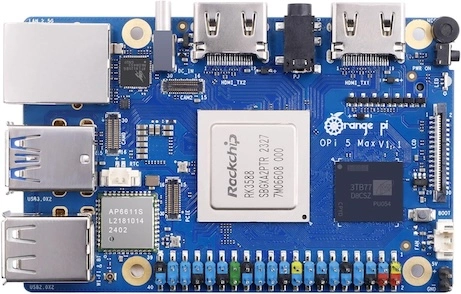Written by
Featured Video
Table of Contents
Components
-
Orange Pi 5 MAX.
-
Acrylic Case
The Orange Pi 5 MAX is an exciting new single-board computer (SBC) that follows in the footsteps of its predecessor, the Orange Pi 5 Pro, while maintaining the same form factor as the Raspberry Pi 5. In this article, we'll dive into the details of the Orange Pi 5 MAX, exploring its various components, performance benchmarks, and practical use cases.
Operating System Compatibility
Orange Pi offers a wide variety of operating systems for the 5 MAX, which can be downloaded directly from their website. These include popular Linux distributions like Ubuntu, Debian, and Arch Linux, as well as an Android image. Additionally, there’s Ubuntu for Rockchip, an open-source project that supports Rockchip SoCs, providing builds specifically for the Orange Pi 5 MAX.
While I initially wanted to run Armbian Linux on this board, support for it isn't available yet.
Update: 26th Sept 2024
A community build image is available. The desktop build is currently not working properly while the server build image works fine. But currently I haven't tested the entire build.
Initial Setup and Desktop Performance
To get started, I installed the Debian image from Orange Pi onto a microSD card for testing. The overall desktop experience was quite smooth, with quick load times for web browsers, minimal lag when moving windows, and overall responsiveness.

I tested media performance by running a 1080p YouTube video, which played smoothly after a few initial frame drops. Switching to 4K resolution yielded similarly smooth results, with no frame drops throughout playback.

Impressively, all of these tests were conducted without using a fan or heatsink, meaning the system ran completely silent.
NVMe Performance
One of the highlights of the Orange Pi 5 MAX is its support for PCIe Gen 3 via a 2280 NVMe slot. After installing an NVMe drive in the M.2 M-key slot, I initially saw transfer speeds of around 220 MB/s. However, after formatting the drive with the Ext4 file system, the speeds jumped to 2,300 MB/s—nearly three times faster than the Raspberry Pi 5, which only supports PCIe Gen 2 with a single lane.
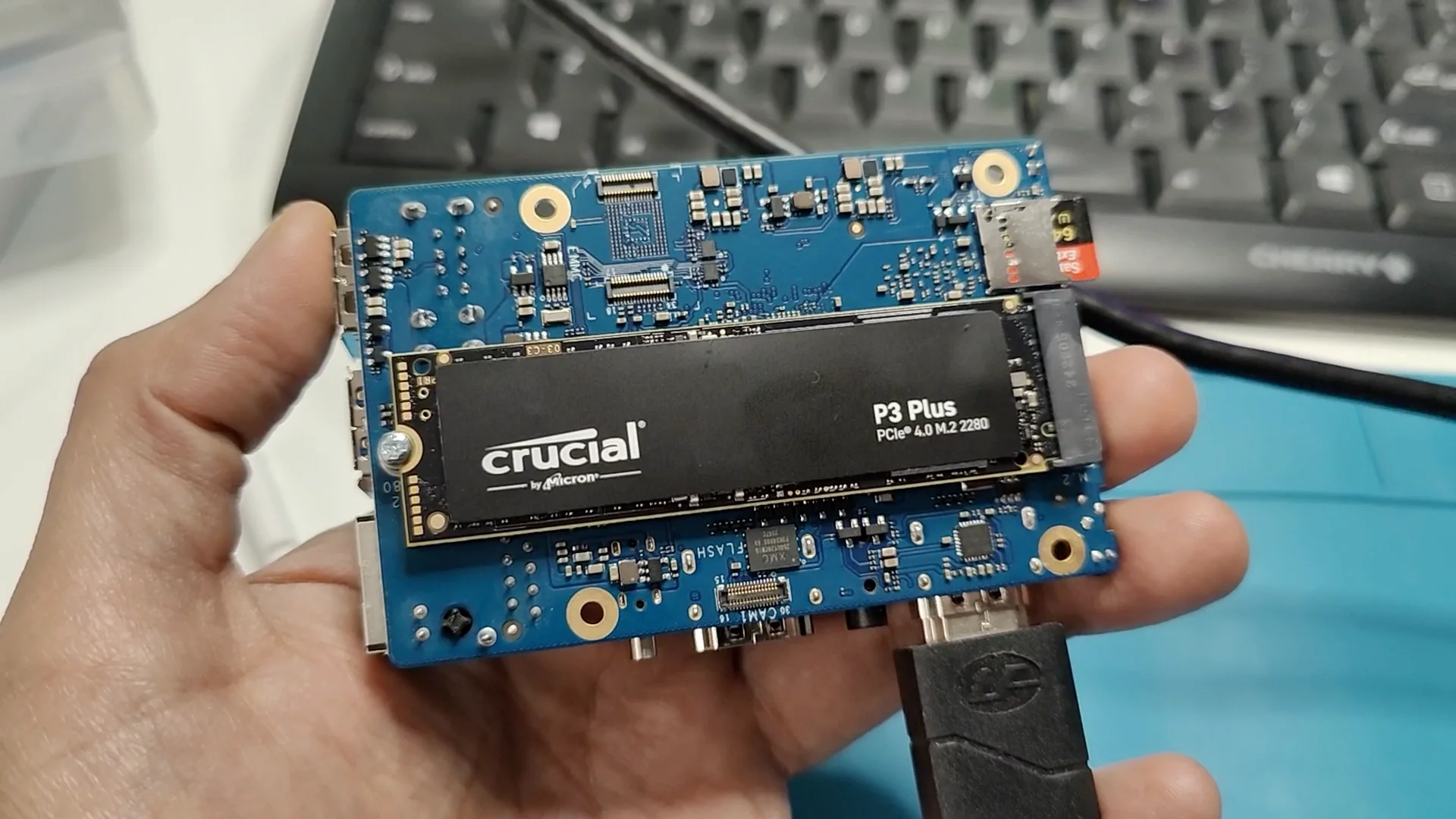
Although I expected speeds closer to 3,900 MB/s, which is the theoretical maximum for PCIe Gen 3 with four lanes, I confirmed via the lspci command that the board was indeed running at PCIe Gen 3 speeds. The takeaway? The Orange Pi 5 MAX offers much faster NVMe speeds than its competitors, and you don’t need an additional hat to achieve them.
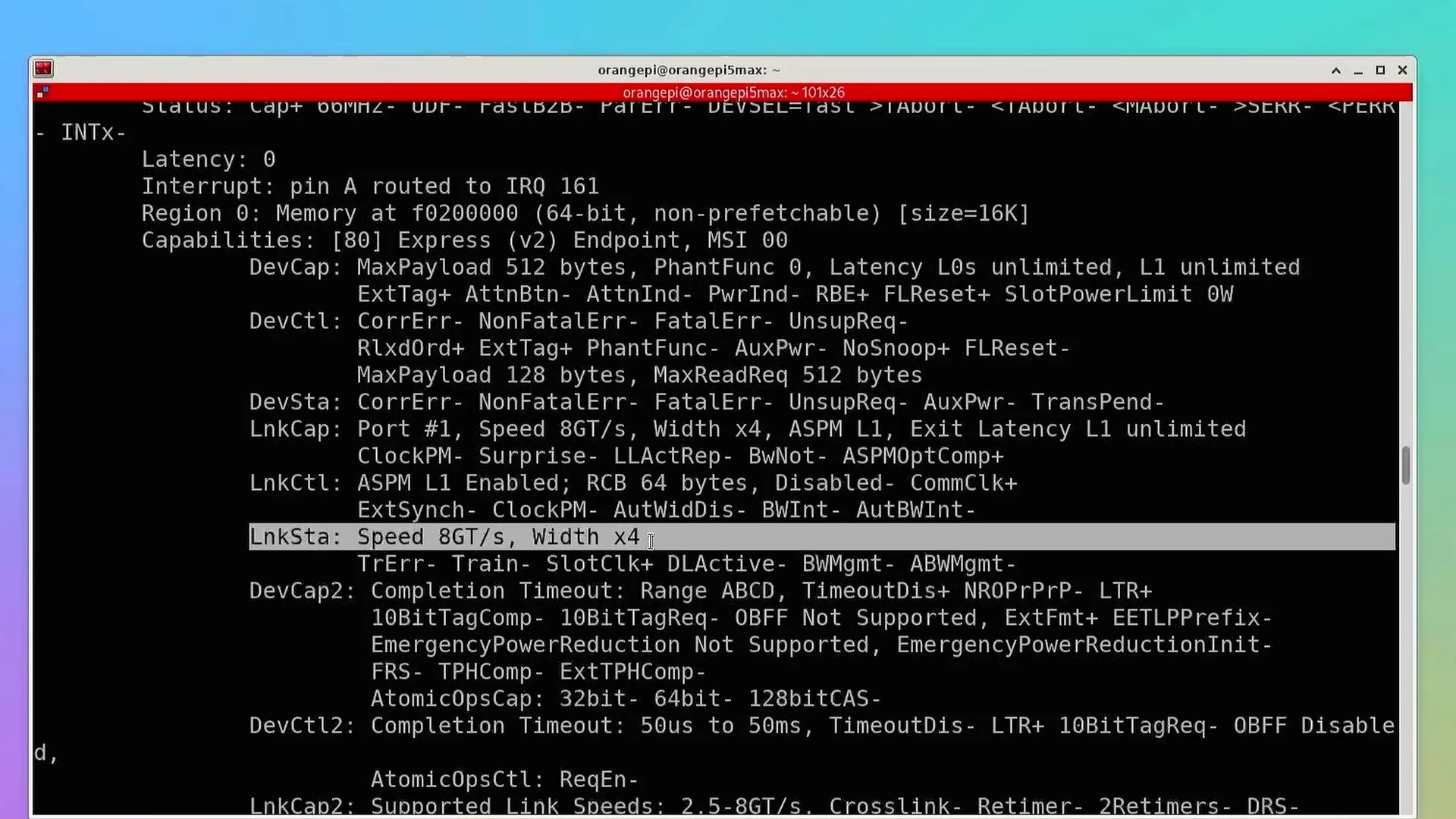
eMMC and Storage Testing
Next, I tested the eMMC module and observed transfer speeds around 300 MB/s—significantly faster than the 60 MB/s from the microSD card. This makes the eMMC a solid option for those seeking faster storage solutions on this SBC.
Benchmark Testing
To evaluate the CPU, I ran several tests:
-
Sysbench: I used sysbench to calculate prime numbers up to 20,000. The board processed 5,300 events per second, completing 100,000 requests in just 19 seconds.
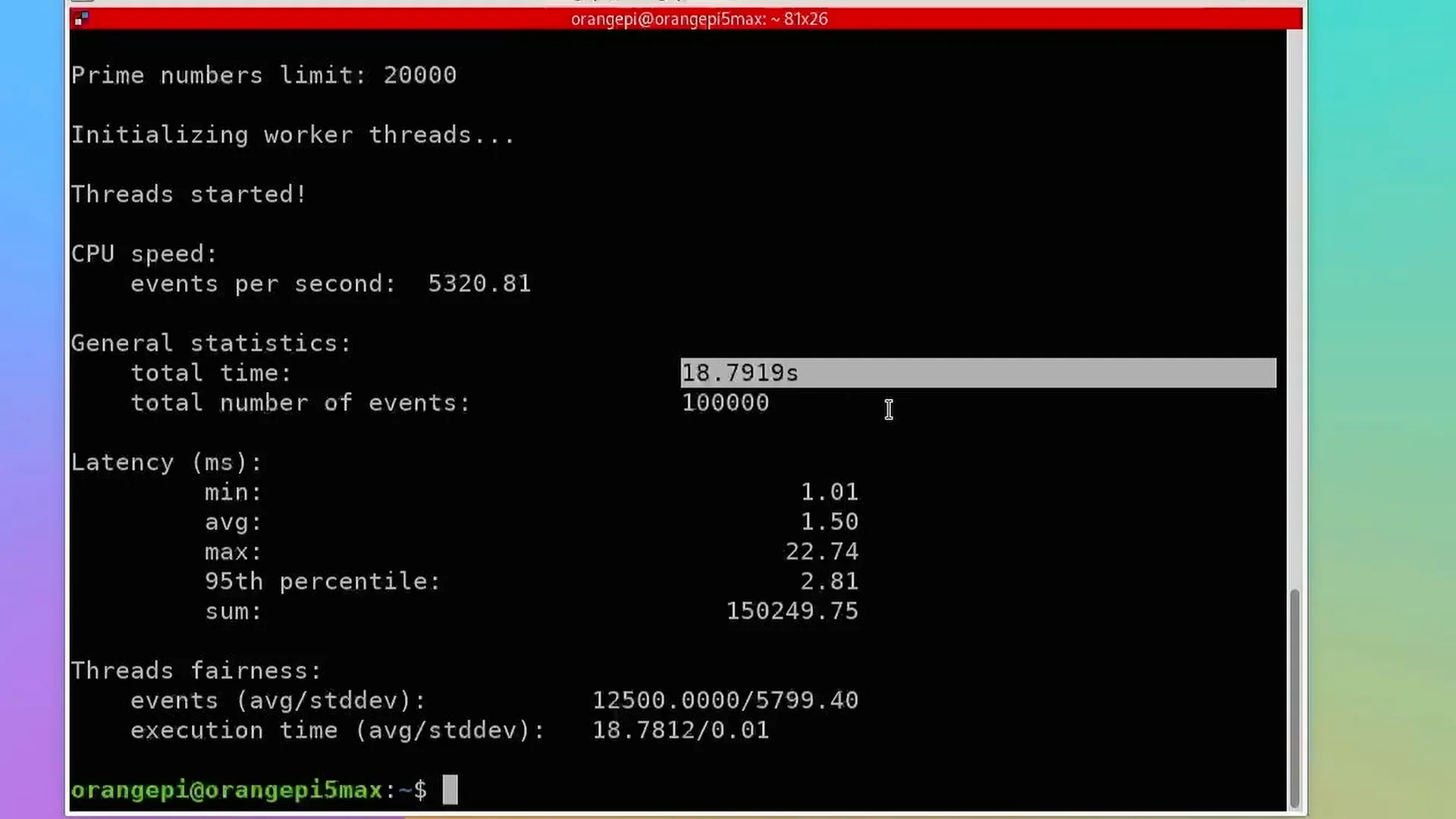
-
Geekbench: In Geekbench tests, the Orange Pi 5 MAX’s single-core performance was slightly lower than the Raspberry Pi 5, likely due to the 1.8 GHz Cortex-A55 core. However, the multi-core performance was 20% better than the Raspberry Pi 5, showcasing the strength of this board in multi-threaded tasks.
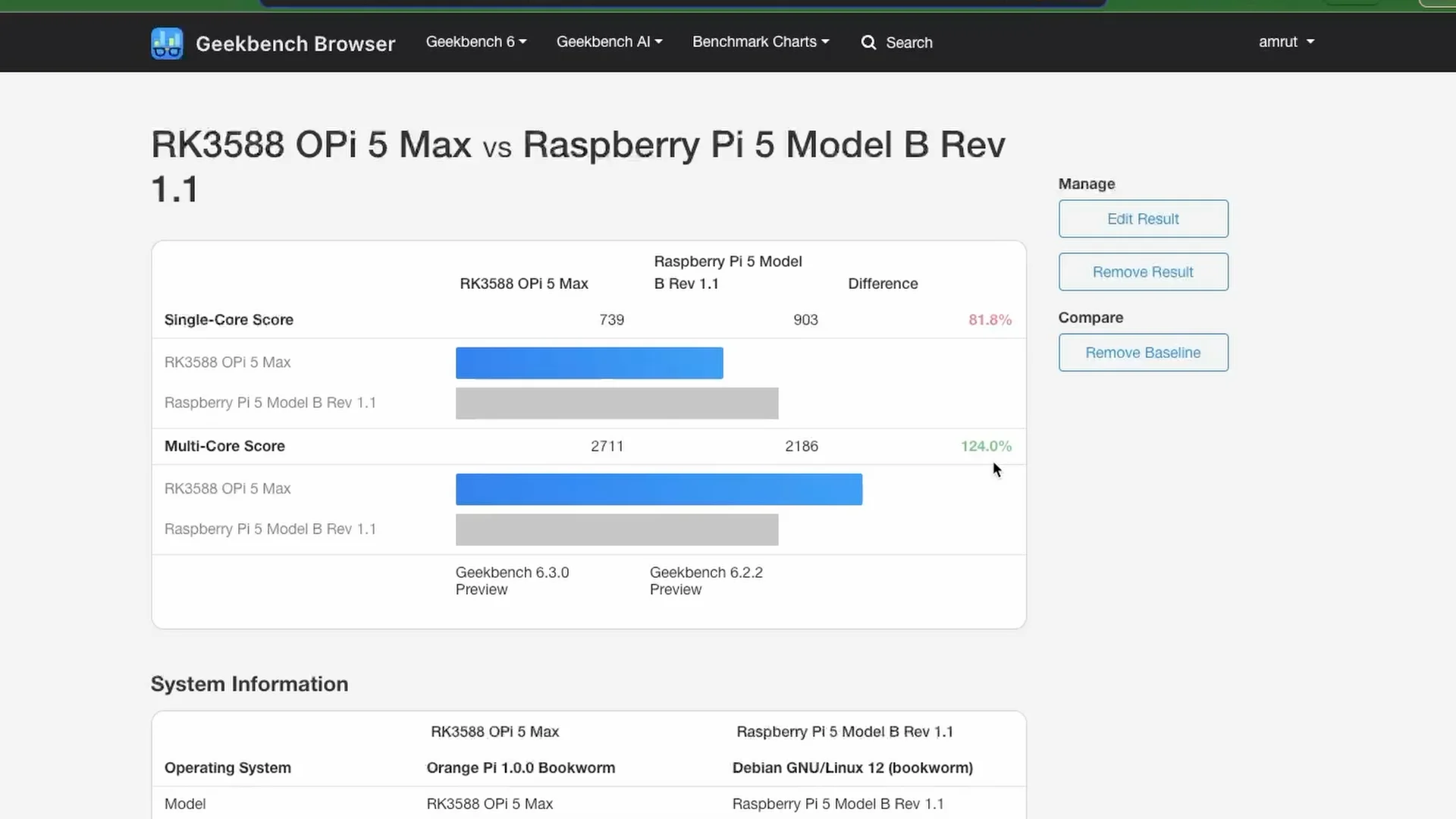
-
Power Consumption & Temperature: The CPU’s temperature rose from 35°C to 60°C during these tests, with power consumption spiking from 2W at idle to 6W under full load. Notably, all tests were performed without a fan.
Network Performance
I also tested the 2.5 Gigabit Ethernet port using iperf3, which achieved impressive speeds of around 2.3 Gbps for both sending and receiving data. This makes the Orange Pi 5 MAX ideal for applications that require high network throughput.
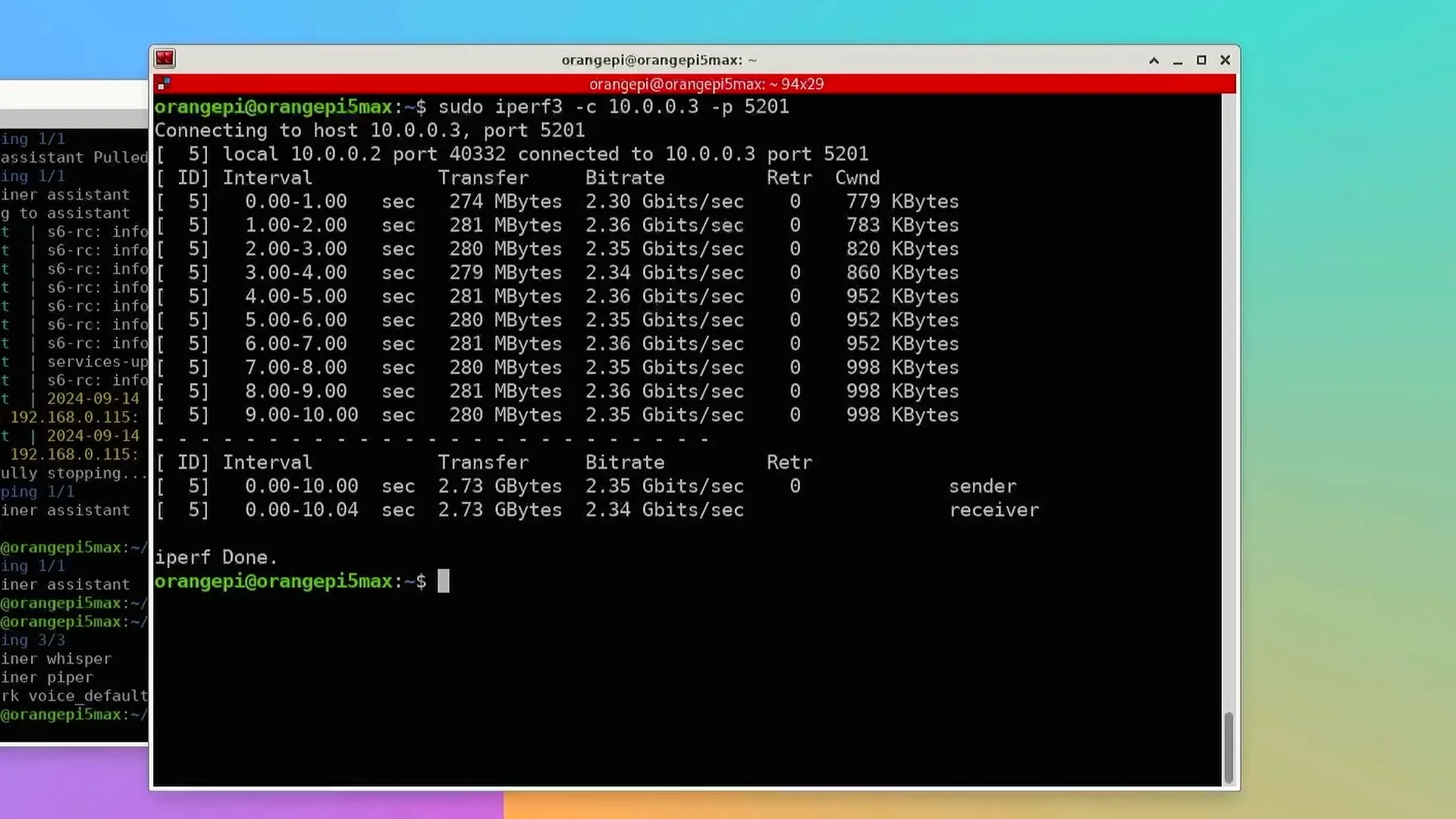
Home Automation and Voice Assistant Testing
Given my interest in home automation, I set up Docker and ran Home Assistant on the board. It worked flawlessly, allowing easy access to the Home Assistant UI. I also tested voice assistants by running Whisper and Piper containers for speech-to-text conversion. The Orange Pi 5 MAX processed speech-to-text in 4 seconds, while the Raspberry Pi 5 took about 14 seconds using the same small-int8 model. Using a smaller tiny-int8 model, the 5 MAX completed the task in 1.2 seconds—twice as fast as the Raspberry Pi 5.
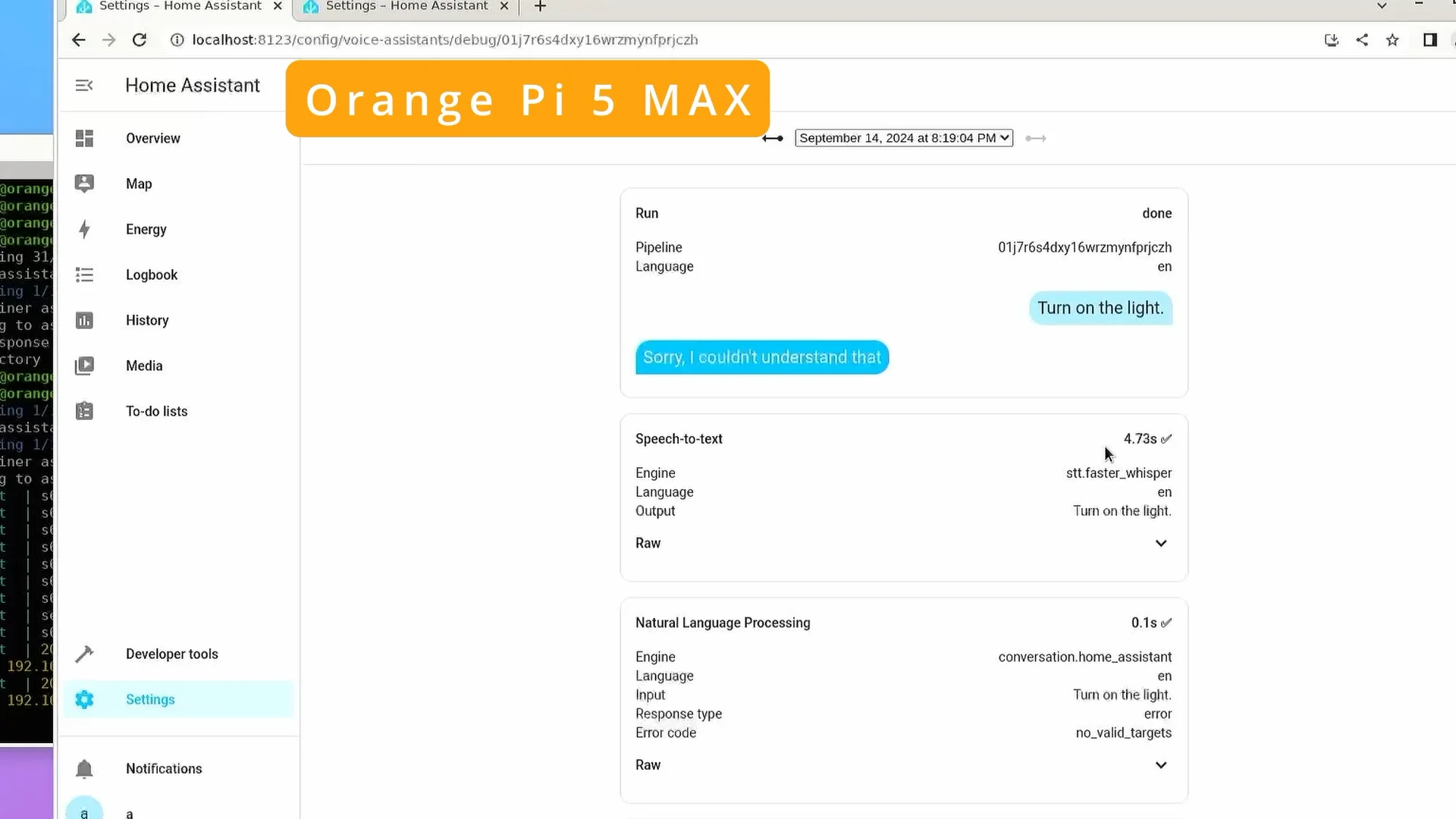
GPIO and Fan Control
To test the GPIO pins, I used the provided gpio command and connected an LED, successfully toggling it using basic commands.
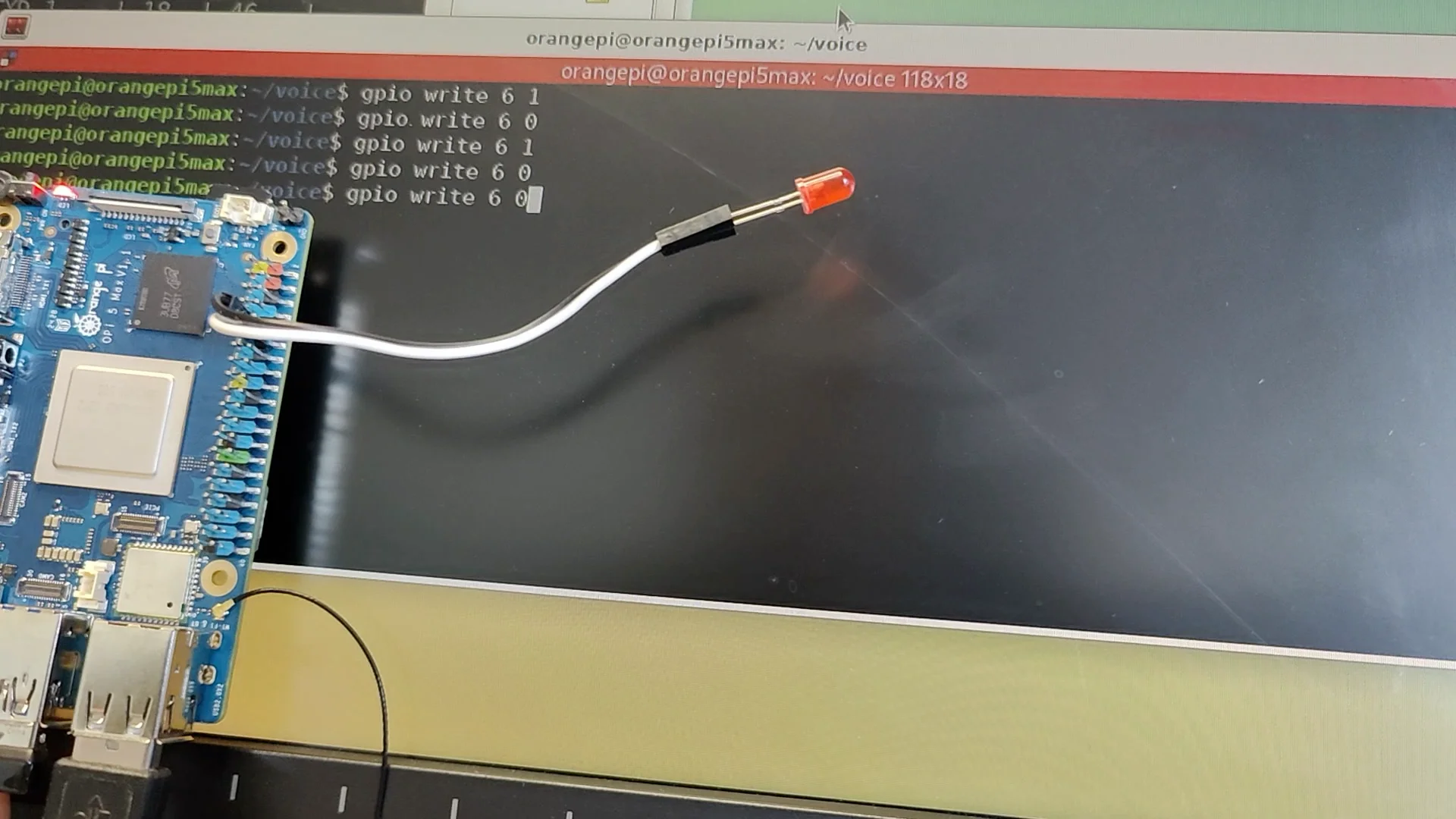
As for cooling, although I couldn’t find an official fan for the board, I used a fan from the Orange Pi 5 Plus to test its response. The fan kicked in once the CPU temperature exceeded 50°C and adjusted its speed according to temperature changes.
For optimal performance, I recommend using this board with a heatsink and a fan, especially if you plan to push the CPU to its limits.
Memory Bandwidth Test
Here is the output of 1 GB of memory bandwidth test.
Memory Bandwidth Test
amrut@orangepi5-max:~$ mbw -s 1024 1000
mbw: invalid option -- 's'
Long uses 8 bytes. Allocating 2*134217728 elements = 2147483648 bytes of memory.
Using 262144 bytes as blocks for memcpy block copy test.
Getting down to business... Doing 10 runs per test.
0 Method: MEMCPY Elapsed: 0.10618 MiB: 1024.00000 Copy: 9643.728 MiB/s
1 Method: MEMCPY Elapsed: 0.10495 MiB: 1024.00000 Copy: 9757.306 MiB/s
2 Method: MEMCPY Elapsed: 0.10495 MiB: 1024.00000 Copy: 9757.120 MiB/s
3 Method: MEMCPY Elapsed: 0.10491 MiB: 1024.00000 Copy: 9760.561 MiB/s
4 Method: MEMCPY Elapsed: 0.10491 MiB: 1024.00000 Copy: 9760.933 MiB/s
5 Method: MEMCPY Elapsed: 0.10494 MiB: 1024.00000 Copy: 9757.771 MiB/s
6 Method: MEMCPY Elapsed: 0.10494 MiB: 1024.00000 Copy: 9757.492 MiB/s
7 Method: MEMCPY Elapsed: 0.10492 MiB: 1024.00000 Copy: 9759.631 MiB/s
8 Method: MEMCPY Elapsed: 0.10497 MiB: 1024.00000 Copy: 9754.982 MiB/s
9 Method: MEMCPY Elapsed: 0.10496 MiB: 1024.00000 Copy: 9756.469 MiB/s
AVG Method: MEMCPY Elapsed: 0.10506 MiB: 1024.00000 Copy: 9746.477 MiB/s
0 Method: DUMB Elapsed: 0.08920 MiB: 1024.00000 Copy: 11479.692 MiB/s
1 Method: DUMB Elapsed: 0.09364 MiB: 1024.00000 Copy: 10935.965 MiB/s
2 Method: DUMB Elapsed: 0.08939 MiB: 1024.00000 Copy: 11455.548 MiB/s
3 Method: DUMB Elapsed: 0.08941 MiB: 1024.00000 Copy: 11452.217 MiB/s
4 Method: DUMB Elapsed: 0.09430 MiB: 1024.00000 Copy: 10858.500 MiB/s
5 Method: DUMB Elapsed: 0.09518 MiB: 1024.00000 Copy: 10758.563 MiB/s
6 Method: DUMB Elapsed: 0.09274 MiB: 1024.00000 Copy: 11041.741 MiB/s
7 Method: DUMB Elapsed: 0.08932 MiB: 1024.00000 Copy: 11464.013 MiB/s
8 Method: DUMB Elapsed: 0.08927 MiB: 1024.00000 Copy: 11470.305 MiB/s
9 Method: DUMB Elapsed: 0.08925 MiB: 1024.00000 Copy: 11474.032 MiB/s
AVG Method: DUMB Elapsed: 0.09117 MiB: 1024.00000 Copy: 11231.691 MiB/s
0 Method: MCBLOCK Elapsed: 0.06921 MiB: 1024.00000 Copy: 14794.908 MiB/s
1 Method: MCBLOCK Elapsed: 0.06832 MiB: 1024.00000 Copy: 14989.387 MiB/s
2 Method: MCBLOCK Elapsed: 0.06806 MiB: 1024.00000 Copy: 15045.990 MiB/s
3 Method: MCBLOCK Elapsed: 0.06831 MiB: 1024.00000 Copy: 14990.923 MiB/s
4 Method: MCBLOCK Elapsed: 0.06808 MiB: 1024.00000 Copy: 15040.686 MiB/s
5 Method: MCBLOCK Elapsed: 0.06749 MiB: 1024.00000 Copy: 15172.843 MiB/s
6 Method: MCBLOCK Elapsed: 0.06800 MiB: 1024.00000 Copy: 15059.045 MiB/s
7 Method: MCBLOCK Elapsed: 0.06741 MiB: 1024.00000 Copy: 15189.723 MiB/s
8 Method: MCBLOCK Elapsed: 0.06749 MiB: 1024.00000 Copy: 15172.618 MiB/s
9 Method: MCBLOCK Elapsed: 0.06758 MiB: 1024.00000 Copy: 15152.412 MiB/s
AVG Method: MCBLOCK Elapsed: 0.06799 MiB: 1024.00000 Copy: 15059.975 MiB/s
Conclusion: A Capable Competitor to Raspberry Pi 5
The Orange Pi 5 MAX offers significant improvements over its predecessor and strong competition to the Raspberry Pi 5. With built-in support for PCIe Gen 3, faster NVMe speeds, and excellent multi-core performance, it’s an excellent option for those looking to build home servers, NAS devices, or home automation systems.
If you're interested in purchasing the Orange Pi 5 MAX, you can find it on AliExpress or Amazon. I’ll be making another video soon to demonstrate its AI capabilities, including the 6 TOPs NPU.
If you are interested in exploring more of such easy to follow step by step guides about Home Assistant, then here are a few suggestions
- Create a NAS with Raspberry Pi 5
- Create Custom Wake Word For Your Voice Assistant
- Share Files With Home Assistant OS with Samba Share

